- Seit
- 16 Apr 2006
- Beiträge
- 59.418
- Xbox Live
- KrateroZ
- PSN
- KrateroZ
- Switch
- 3314 2616 9318
- Steam
- KrateroZ
Packt hier alles rein, was mit Retro-Spielen und/oder -Konsolen zu tun hat (Interviews, Diskussionen, Schwärmen von Retro-Spiel XYZ usw.) 
Ich fange mal an und poste ein interessantes Interview mit
Brian Fehdrau (Lead Programmer von Secret of Evermore):
---------------------------------------------------------
Interview with Brian Fehdrau - Secret of Evermore
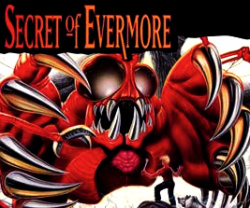 The man behind Secret of Evermore speaks!
The man behind Secret of Evermore speaks!
We recently got a chance to talk with the lead programmer of Secret of Evermore and found out some very interesting information regarding the development of this unique Super Nintendo RPG title.
Brian Fehdrau was the lead programmer on the Squaresoft USA team that developed the Super Nintendo rpg hit Secret of Evermore. We were recently able to catch up with Brian and he was kind enough to take time out of his busy schedule to take part in an interview with Nintendo Life. You can check out the full content of the interview below.
NINTENDO LIFE: A big deal was made about Secret of Evermore being one of the few console rpgs of the time period to be developed by an American development group. What was it like being part of a group that was responsible for creating one of the first fully US-developed console rpg titles?
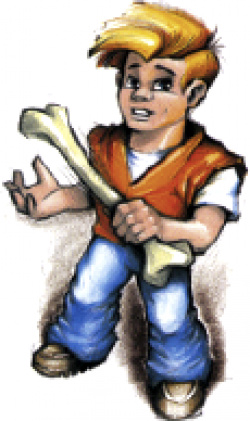 Our protagonist
Our protagonist
BRIAN FEHDRAU: It was actually pretty exciting. It was my first job in the industry, and to get dropped into a major new foray by one of the world's best RPG developers was a real lucky break for me. Since we built the team, the tools, and the game from the ground up, in unfamiliar territory, it was kind of like being a pioneer in a big new world. It was scary, but we sure learned a lot.
NL: Was their a lot of emphasis placed on making sure Secret of Evermore had a very "American" feel to it?
BF: Yes, very much so. That was practically our Prime Directive, so to speak, coming straight down from Starfleet Command over at Square Co. Ltd. in Japan, our mother company. We were, simply put, to make an American-flavored Secret-of-Mana-like game. The exact details of how we did it were up to us, but what we did had to be infused with that essence. That was the basis for the creation of the new Seattle studio and its team.
NL: Can you tell us a little about the S.A.G.E. (Square's Amazing Graphical Editor) and the S.I.G.I.L. (Square Interpreted Game Intelligence Language) programs that were used to help create Secret of Evermore?
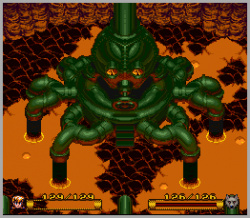 The magma volcano
The magma volcano
BF: SAGE was a custom Mac application that allowed you to edit all graphical components of the game, including tiles, maps, characters, animations, effects, that sort of thing. It was also capable of hooking up with some simple SNES test hardware so the artist could run around the map with a real character and test things. That also allowed them to see their work on a real NTSC television, whose colorspace is a strange and wicked thing, quite unlike their computer monitor.
Conceptually, SAGE wasn't terribly complicated. Typically, you'd collect a small palette of tiles on the left from the larger set available to the whole game, and then arrange those somehow in a large work area on the right. On a map, you'd have a palette of 256 16x16 tiles that you could place in various layers of a large gridded map, and have them sort in clever ways to make things like fences or waist-deep water. With a character/animation, you'd instead arrange a set of 8x8 and 16x16 tiles in a totally arbitrary manner, to minimally cover the area of the current frame of animation. Character/sprite tiles are at a premium on a SNES, so you must be very economical.
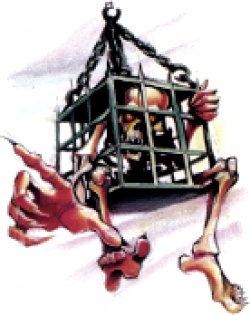 I hope that cage holds!
I hope that cage holds!
SIGIL was a simple, high-level scripting language. It could do full mathematical expressions and shuffle variables around as you might expect, but its core functions were higher concepts like WALKTO, TURNLEFT, WAITFOR, (go to) MAP, and tons of similar stuff for controlling scripted scenes, entrances/exits from maps, and game states. These could reference named map locations, triggers, animations, etc. that were set up in SAGE. All of this made it much easier for a novice to work in the language: you didn't need to be a trained programmer, and you usually didn't need numbers. At the same time, the tools were there for programmers to do more complicated things. SIGIL turned out pretty well.
In case any of your tech-minded readers are interested: under the hood, SIGIL was tokenized into bytes, used reverse polish representation for expressions, had local/map/global scope for variables, and could run multiple scripts in parallel.
NL: Secret of Evermore has often gotten the incorrect distinction of being the game that US gamers received instead of Seiken Densetsu 3, which would have been the true sequel to our Secret of Mana. Why do you think that is and what do you have to say to those who believe this?
BF: Well, you can't really blame people for thinking that. It was a reasonable guess, it just happened to be incorrect. I was also disappointed when Seiken Densetsu 3 didn't get the US nod, but I had a chance to play the Japanese version, so I know it had some bugs. People who have played Seiken Densetsu 3 via emulation might know what I'm talking about. At the time, Nintendo was extremely strict about its zero-bug policy, and even with Square's history with Nintendo, I think they might have had a difficult time getting it through certification. They also might have had trouble getting the American consumer to accept its flaws without returning it to the store, which was much more common then. Of course, then we went and shipped Evermore with some bugs, so who I am to talk?
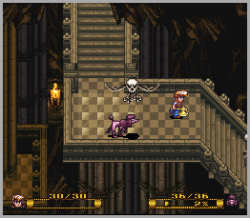 Too many stairs, too little time!
Too many stairs, too little time!
Anyway, the common belief is that resources were re-allocated to develop Evermore, rather than to bring Seiken Densetsu 3 to North America. I can assure you that no one was re-allocated. The entire Evermore team was built from the ground up with new hires. None of the people involved in North American localizations were tied up by our game. In fact, if memory serves, Breath of Fire, Chrono Trigger, and Final Fantasy 6 were all localized for North America while we were in development.
NL: Other than Secret of Evermore, were there any other Super Nintendo RPGs that really impressed you and if so, why?
BF: Well, Secret of Mana probably deserves the nod, to be sure. It was beautiful, smooth, big, had interesting gameplay, a good story, and an innovative interface. Prior to that, I'd only played things like Zelda, or further back, the Ultima series on PC, so it was a quantum leap to see Secret of Mana. I didn't take much to Final Fantasy, but Mana was great.
I only played other SNES RPGs in dribs and drabs for reference and research. I never had the time to play them at length, so I can't really make a good call on them. As I recall, Earthbound was fun, and Star Ocean was very pretty.
 Sweet music, but one creepy dude
Sweet music, but one creepy dude
As an aside, even though it's not an RPG, I have to say I loved Rock & Roll Racing for the SNES. Snappy game, great music, fun frag-your-pal multiplayer, just an all-around hoot to play with friends or co-workers.
NL: It's been stated that although the combat and "Ring" menu systems used in Secret of Evermore are very similar to those found in Secret of Mana, that you guys programmed the system used in Evermore from scratch. Why were these recreated being that they already existed in Secret of Mana, and why was it decided to make them so similar in look and function?
BF: There was some reason why we had to develop from the ground up, but, to be honest, I can't remember what it was. I think it was one of those strange we're-wholly-owned-but-separate-for-tax-purposes sorts of things. Regardless, we did indeed end up writing absolutely everything from scratch, both on the tool side and on the game side.
 Taking a ride
Taking a ride
There were two fairly simple reasons for swiping some of our systems from Mana. For one, we were supposed to be creating a Mana-like game, so it made sense to retain the interface. For another, those systems were proven to work well, and if you can steal the design for the wheel without getting sued for patent infringement... eh, why not? We also stole a couple of interface ideas from Final Fantasy 6, by the way.
The upside of rewriting their systems from scratch is that we had the option of tweaking or replacing things without having to tear up unfamiliar code and smush something different into it. Putting in alchemy, for instance, might have been difficult, and that would have been a shame. I think our map engine was more flexible as well.
NL: We read that Secret of Evermore was made a single-player game in order to conserve memory, as the game was originally planned as a 12-megabit game title but ultimately ended up being a 24-megabit game. Was there a growing concern as the game's file size continued to grow, finally ending up being twice as large as originally planned?
 That's just sick!
That's just sick!
BF: The single-player-game choice was actually an attempt to reduce complexity. We were a brand new team, many of us new to the industry, and it just seemed wise to eliminate risks. Having two or more players independently controlling characters on a large scrolling map is a bit of a minefield. Early on, we had experienced a couple of instances where we managed to get our characters stuck in Secret of Mana, and had to reload the last save. That worried us. If an experienced and clever team in Japan hadn't quite gotten it right, it looked bad for us. In retrospect, I really wish we had sucked it up and worked out the kinks. I think that was a real failure on our part.
Size-wise, the game was originally rather different, aimed at a smaller world and a shorter period of gameplay with somewhat simpler graphics. Over time, we came to believe the original game was simply not worthy, and we ended up doing a near-total redesign. I think that eventually bumped us up to 16mbits as we enlarged the world. We did have many instances of "OhCrapWeAreOverAGAIN," but that's normal in games, and we adjusted as necessary. It didn't actually drive the cart size.
As I recall, it was actually more to do with falling manufacturing costs and rising interest in a bigger game. One day, out of the blue, we found out we had been bumped to 24mbits, and I don't think we'd even been asking for it, at least not with any real hope. We were pretty happy, as it allowed us to flesh out some areas, (re)add animations, (re)add more variation, more sound/music, etc. In the end, we still managed to overflow the 24mbit size on a regular basis. I think when we shipped, we had only a handful of free bytes.
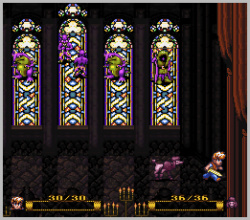 Beautiful stained glass
Beautiful stained glass
NL: Is there one particular aspect of Secret of Evermore that you as a programmer are most proud of?
BF: That's a tough one. We really did everything, absolutely everything, with little or no prior experience and no outside help, and that's something to be proud of, all by itself. I'm also proud of the fact that we managed to mimic the Secret of Mana engine pretty faithfully, to the point that most people think we inherited the code and tweaked it for our own purposes.
My personal, specific favorite is probably SIGIL. I had a lot of fun setting up and tweaking the language, its encoding, the interpreter, the text compressor, etc. It was a tiny opportunity to be the god of my own little language, to create it and mold it and see it off on its way into the world. I wish I still had the source code for it. I'd like to see it again.
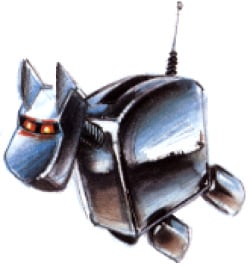 Futuristic dog
Futuristic dog
I also got a little personal thrill when a few people from Japan came around to visit and looked at an early version of our map editor, and then went back and made one of their own that looked just like it. I chuckled.
NL: Jeremy Soule was a virtual newcomer to the video game music scene when he was hired on by Squaresoft to score Secret of Evermore. Were you impressed with what he was able to create for the game's soundtrack given so little experience at the time?
BF: Oh, hell, yes. Jeremy's a savant. He sent in this amazing orchestral demo music, and he was, what, 19 at the time? Something like that. How could we not hire him? He lived and breathed music, and he was good at it. He actually took the apartment across the hall from me for a while, and I think the ratio of music equipment to furniture in there was something like 20:1. If he couldn't play music on it, or sleep on it, I don't think he needed it.
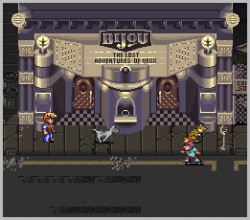 Outside the bijou
Outside the bijou
What was really great about Jeremy was his ability to economize and yet still produce great sound and music. Imagine being a guy who is used to full-featured midi keyboards with huge banks of digital instruments, to the point that you can almost single-handedly produce a vast orchestral piece. Then imagine you get a job writing low-fidelity SNES sound and music, with strange and klunky proprietary software, fitting into memory smaller than a single cluster on a modern PC's hard drive. Most people would sit down and cry, and then go out and find another job. Not Jeremy. He muttered a bit, and then made it work. Every now and then, I'd have to go and tell him his budget was a littler smaller than we'd hoped. He'd mutter a bit, and then make it work. He was a real trooper, and a genius to boot. Jeremy's work in Evermore is one of its primary assets. I'm really glad he's gone on to be a big success. I'm not sure it's my place to say I'm proud of him, but I am.
By the way, I've spoken well of our programming staff and Jeremy, but the art and design staff deserve a nod as well. Gameplay and sound are only two thirds of the equation. We had tons of really great content that deserves its own kudos. Our designers, map/script editors, character artists, and background artists were all top-notch, and often remarkably innovative and clever.
NL: Was a sequel to Secret of Evermore ever considered?
BF: Yes, actually. Only briefly, though. We started looking at what we could do, but then the corporate folks decided that the SNES market was on the decline, so we abandoned that. We were all relieved, to be honest, as we had just been on a six month deathmarch to finish Evermore, and we weren't terribly eager to revisit the material at the time. After that, we started looking at doing PC titles instead. That didn't pan out either, as the Seattle office got closed in favor of the L.A. office, and we all got nice little severance packages.
 Can you say aerobics?
Can you say aerobics?
NL: Were there any particular areas of programming Secret of Evermore that proved to be overly difficult or tricky?
BF: Hmm. We spent a lot of time on data compression. The game was probably more like 50-70mbits, uncompressed, maybe more. We had different ways of compressing nearly everything: maps, map tiles, sprite tiles, scripts, dialogue, etc. Some of them had to be decompressed very, very quickly, every frame. That was a real challenge. Beyond that, it's hard to say. An RPG is inherently a tricky thing, and the SNES is a wacky piece of hardware; everything we did was kind of tricky in its own way.
NL: Do you still own a copy of Secret of Evermore and if so, do you ever play it?
BF: I still have a copy. Three, in fact. One pristine, one actually used, and one in German. I last played a few years ago, though honestly I found it more convenient to play it on an emulator on my laptop. The instant total memory save/restore rules all.
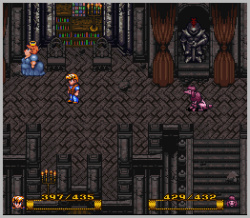 Time to get moving!
Time to get moving!
For a very long time, I was actually reluctant to go back and play Evermore. I had developed a feeling like the game had turned out poorly, and I didn't want to have to look at it. When people would tell me they'd played it, I would apologize to them. The problem was that, at the time it was released, we had gotten panned by many reviewers, which didn't do much for my ego or my opinion of our game. We'd taken a lot of flack for not being Seiken Densetsu 3, and for being a Square game that wasn't full of Japanese mythology. We'd also made some bad choices (e.g. no multiplayer) and shipped with a few bad scripting bugs in the puzzles. Worst of all, I think, we'd placed the last save point before the first big boss way too far ahead, and so when you inevitably didn't figure out the winning trick fast enough and died, it was very upsetting to go back so far. That even happened to me after I got my freebie retail cartridge. I swore at the game, turned it off, and didn't touch it again for ten years. I'm really self-critical by nature, and the thought that all of our efforts had produced a dud was quite upsetting.
However, when I committed to playing again on the emulator (and quick-saved before that boss!), I found that the game was actually much better than I remembered. Sure, the dialogue's hokey, there are a few glitches, and some of the maps are a bit silly, but overall, the depth, breadth, length, and quality of the gameplay really surprised me. I actually had a lot of fun building up my character, kicking ass, (re)discovering the worlds, and taunting the chickens. These days, I'm a lot more proud, even fond, of Evermore.
NL: What do you think about Nintendo's Wii Virtual Console service and would you like to see Secret of Evermore released on the Virtual Console so that it might gain a new audience with gamers who might have missed the game the first time around?
 Your dog looks unhappy!
Your dog looks unhappy!
BF: I've only had a Wii for a short period and I haven't actually used the Virtual Console yet, but I've looked at the library, and I really like the idea. I don't know exactly what it does under the hood, so I don't know how well it could emulate Evermore. If it's a straight-up emulator like we use on our PC's, then I suppose it would just be a matter of Nintendo striking a deal with Square for the rights. I think Square should get its entire back catalog up there, really. I'm sure many people would gobble it up, even people who've never heard of Square's SNES titles.
I think it's a great idea for people to discover what they missed back in the SNES days. The SNES was the first console that really had the chops to hold up over time. Most NES games are kind of ... meh ... these days, but a lot of the SNES titles are still just as fun and look great. I've enjoyed seeing people discover Evermore via PC emulation, so it would be great if even more could encounter it on their Wii. I'd hope they could make use of some of the patches people have done, e.g. the Silver Sheath fix, maybe the multiplayer patch, etc.
NL: Are you still working in the video game industry and if so, do you have any current projects in the works?
 Prehistoric swamps
Prehistoric swamps
BF: Yup, I'm just about a week away from my 15th anniversary in the games industry.
After Squaresoft, I worked on N64 racing games for a few years with Boss Game Studios. That was a lot of fun, as we always tried to be cutting-edge, and usually did quite well. I often miss working on racing games, but at least now I can play them without feeling like a gynecologist on his wedding night.
These days, I work for the Seattle-area Foundation 9 Entertainment studio, one of about a dozen worldwide. I'm the chief engineer on one of our in-house cross-platform game engines, so I don't generally work on specific titles myself, though I do get to put my name somewhere deep in the credits of every title that uses it. We do mostly licensed/franchised console titles, things like movie licenses or game sequels and alternate platform versions. (I can't name names, thanks to strict non-disclosure agreements.) It's a little more laid-back than doing single-console, single-purpose games, but it's a fun challenge to deal with the often-massive differences in the underlying hardware.
 Carltron the butler
Carltron the butler
NL: In closing, why do you think so many of today's gamers still enjoy these classic 16-bit rpgs, like Secret of Evermore, and do you have anything you'd like to say to the many Secret of Evermore fans out there that still enjoy playing the game, even 14 years later?
BF: It's probably different for everyone. I think it's safe to say that those of us who played the games back then remember them, and that time of our lives, fondly. As I said earlier, I'd played RPGs before, but games like Mana were the first ones where I felt like I was part of the story, rather than simply moving a colored block around a grid of other colored blocks and making numbers go up. It's nice to relive that discovery, a sort of nostalgia thing.
There's also the fact that many of the games really were that good, in today's terms or otherwise. Back then, it just wasn't feasible to make a very pretty game that played like complete crap. In fact, other than your artists' efforts, and some time put into the obligatory Mode 7 flyabout, there wasn't a whole lot you could do to go above and beyond what your competitors were showing. Visual quality sort of leveled off after a while. People simply had to write games that were fun, if they wanted to sell games, not have them returned to the store, and then go on to sell the games' sequels as well. That's why I think a lot of them still hold up so well.
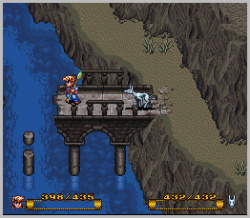 Unfinished bridges are no fun!
Unfinished bridges are no fun!
I'd really encourage your readers to check out all the old SNES RPGs. If you liked Evermore, there's still a lot more out there that'll turn your crank. There are so many options available these days, be it carts off of eBay, or emulation on everything from PCs to MP3 players, that there's really no reason why everyone can't experience the full heyday of 16-bit RPGs. In fact, I'm getting the urge myself, as I speak.
To the Evermore fans specifically, I want to close by saying thanks for all the kind words and support. I never would have thought that people would still be playing the game, let alone enjoying it, so many years later. I think I probably speak for the rest of the team when I say we're glad to have been of service.

NL: Thanks Brian for taking the time to do the interview. It's very much appreciated.
BF: I'm happy to oblige. I always enjoy talking about Secret of Evermore.
http://retro.nintendolife.com/news/2009/04/interview_with_brian_fehdrau_secret_of_evermore
--------------------------------------------------------
Persönlich gefiel mir Secret of Evermore besser als Secret of Mana - vor allem der Hund, der sich je nach Zeitperiode immer wieder verändert hat, war gut gemacht.

Ich fange mal an und poste ein interessantes Interview mit
Brian Fehdrau (Lead Programmer von Secret of Evermore):
---------------------------------------------------------
Interview with Brian Fehdrau - Secret of Evermore
 The man behind Secret of Evermore speaks!
The man behind Secret of Evermore speaks!We recently got a chance to talk with the lead programmer of Secret of Evermore and found out some very interesting information regarding the development of this unique Super Nintendo RPG title.
Brian Fehdrau was the lead programmer on the Squaresoft USA team that developed the Super Nintendo rpg hit Secret of Evermore. We were recently able to catch up with Brian and he was kind enough to take time out of his busy schedule to take part in an interview with Nintendo Life. You can check out the full content of the interview below.
NINTENDO LIFE: A big deal was made about Secret of Evermore being one of the few console rpgs of the time period to be developed by an American development group. What was it like being part of a group that was responsible for creating one of the first fully US-developed console rpg titles?
 Our protagonist
Our protagonistBRIAN FEHDRAU: It was actually pretty exciting. It was my first job in the industry, and to get dropped into a major new foray by one of the world's best RPG developers was a real lucky break for me. Since we built the team, the tools, and the game from the ground up, in unfamiliar territory, it was kind of like being a pioneer in a big new world. It was scary, but we sure learned a lot.
NL: Was their a lot of emphasis placed on making sure Secret of Evermore had a very "American" feel to it?
BF: Yes, very much so. That was practically our Prime Directive, so to speak, coming straight down from Starfleet Command over at Square Co. Ltd. in Japan, our mother company. We were, simply put, to make an American-flavored Secret-of-Mana-like game. The exact details of how we did it were up to us, but what we did had to be infused with that essence. That was the basis for the creation of the new Seattle studio and its team.
NL: Can you tell us a little about the S.A.G.E. (Square's Amazing Graphical Editor) and the S.I.G.I.L. (Square Interpreted Game Intelligence Language) programs that were used to help create Secret of Evermore?
 The magma volcano
The magma volcanoBF: SAGE was a custom Mac application that allowed you to edit all graphical components of the game, including tiles, maps, characters, animations, effects, that sort of thing. It was also capable of hooking up with some simple SNES test hardware so the artist could run around the map with a real character and test things. That also allowed them to see their work on a real NTSC television, whose colorspace is a strange and wicked thing, quite unlike their computer monitor.
Conceptually, SAGE wasn't terribly complicated. Typically, you'd collect a small palette of tiles on the left from the larger set available to the whole game, and then arrange those somehow in a large work area on the right. On a map, you'd have a palette of 256 16x16 tiles that you could place in various layers of a large gridded map, and have them sort in clever ways to make things like fences or waist-deep water. With a character/animation, you'd instead arrange a set of 8x8 and 16x16 tiles in a totally arbitrary manner, to minimally cover the area of the current frame of animation. Character/sprite tiles are at a premium on a SNES, so you must be very economical.
 I hope that cage holds!
I hope that cage holds!SIGIL was a simple, high-level scripting language. It could do full mathematical expressions and shuffle variables around as you might expect, but its core functions were higher concepts like WALKTO, TURNLEFT, WAITFOR, (go to) MAP, and tons of similar stuff for controlling scripted scenes, entrances/exits from maps, and game states. These could reference named map locations, triggers, animations, etc. that were set up in SAGE. All of this made it much easier for a novice to work in the language: you didn't need to be a trained programmer, and you usually didn't need numbers. At the same time, the tools were there for programmers to do more complicated things. SIGIL turned out pretty well.
In case any of your tech-minded readers are interested: under the hood, SIGIL was tokenized into bytes, used reverse polish representation for expressions, had local/map/global scope for variables, and could run multiple scripts in parallel.
NL: Secret of Evermore has often gotten the incorrect distinction of being the game that US gamers received instead of Seiken Densetsu 3, which would have been the true sequel to our Secret of Mana. Why do you think that is and what do you have to say to those who believe this?
BF: Well, you can't really blame people for thinking that. It was a reasonable guess, it just happened to be incorrect. I was also disappointed when Seiken Densetsu 3 didn't get the US nod, but I had a chance to play the Japanese version, so I know it had some bugs. People who have played Seiken Densetsu 3 via emulation might know what I'm talking about. At the time, Nintendo was extremely strict about its zero-bug policy, and even with Square's history with Nintendo, I think they might have had a difficult time getting it through certification. They also might have had trouble getting the American consumer to accept its flaws without returning it to the store, which was much more common then. Of course, then we went and shipped Evermore with some bugs, so who I am to talk?
 Too many stairs, too little time!
Too many stairs, too little time!Anyway, the common belief is that resources were re-allocated to develop Evermore, rather than to bring Seiken Densetsu 3 to North America. I can assure you that no one was re-allocated. The entire Evermore team was built from the ground up with new hires. None of the people involved in North American localizations were tied up by our game. In fact, if memory serves, Breath of Fire, Chrono Trigger, and Final Fantasy 6 were all localized for North America while we were in development.
NL: Other than Secret of Evermore, were there any other Super Nintendo RPGs that really impressed you and if so, why?
BF: Well, Secret of Mana probably deserves the nod, to be sure. It was beautiful, smooth, big, had interesting gameplay, a good story, and an innovative interface. Prior to that, I'd only played things like Zelda, or further back, the Ultima series on PC, so it was a quantum leap to see Secret of Mana. I didn't take much to Final Fantasy, but Mana was great.
I only played other SNES RPGs in dribs and drabs for reference and research. I never had the time to play them at length, so I can't really make a good call on them. As I recall, Earthbound was fun, and Star Ocean was very pretty.
 Sweet music, but one creepy dude
Sweet music, but one creepy dudeAs an aside, even though it's not an RPG, I have to say I loved Rock & Roll Racing for the SNES. Snappy game, great music, fun frag-your-pal multiplayer, just an all-around hoot to play with friends or co-workers.
NL: It's been stated that although the combat and "Ring" menu systems used in Secret of Evermore are very similar to those found in Secret of Mana, that you guys programmed the system used in Evermore from scratch. Why were these recreated being that they already existed in Secret of Mana, and why was it decided to make them so similar in look and function?
BF: There was some reason why we had to develop from the ground up, but, to be honest, I can't remember what it was. I think it was one of those strange we're-wholly-owned-but-separate-for-tax-purposes sorts of things. Regardless, we did indeed end up writing absolutely everything from scratch, both on the tool side and on the game side.
 Taking a ride
Taking a rideThere were two fairly simple reasons for swiping some of our systems from Mana. For one, we were supposed to be creating a Mana-like game, so it made sense to retain the interface. For another, those systems were proven to work well, and if you can steal the design for the wheel without getting sued for patent infringement... eh, why not? We also stole a couple of interface ideas from Final Fantasy 6, by the way.
The upside of rewriting their systems from scratch is that we had the option of tweaking or replacing things without having to tear up unfamiliar code and smush something different into it. Putting in alchemy, for instance, might have been difficult, and that would have been a shame. I think our map engine was more flexible as well.
NL: We read that Secret of Evermore was made a single-player game in order to conserve memory, as the game was originally planned as a 12-megabit game title but ultimately ended up being a 24-megabit game. Was there a growing concern as the game's file size continued to grow, finally ending up being twice as large as originally planned?
 That's just sick!
That's just sick!BF: The single-player-game choice was actually an attempt to reduce complexity. We were a brand new team, many of us new to the industry, and it just seemed wise to eliminate risks. Having two or more players independently controlling characters on a large scrolling map is a bit of a minefield. Early on, we had experienced a couple of instances where we managed to get our characters stuck in Secret of Mana, and had to reload the last save. That worried us. If an experienced and clever team in Japan hadn't quite gotten it right, it looked bad for us. In retrospect, I really wish we had sucked it up and worked out the kinks. I think that was a real failure on our part.
Size-wise, the game was originally rather different, aimed at a smaller world and a shorter period of gameplay with somewhat simpler graphics. Over time, we came to believe the original game was simply not worthy, and we ended up doing a near-total redesign. I think that eventually bumped us up to 16mbits as we enlarged the world. We did have many instances of "OhCrapWeAreOverAGAIN," but that's normal in games, and we adjusted as necessary. It didn't actually drive the cart size.
As I recall, it was actually more to do with falling manufacturing costs and rising interest in a bigger game. One day, out of the blue, we found out we had been bumped to 24mbits, and I don't think we'd even been asking for it, at least not with any real hope. We were pretty happy, as it allowed us to flesh out some areas, (re)add animations, (re)add more variation, more sound/music, etc. In the end, we still managed to overflow the 24mbit size on a regular basis. I think when we shipped, we had only a handful of free bytes.
 Beautiful stained glass
Beautiful stained glassNL: Is there one particular aspect of Secret of Evermore that you as a programmer are most proud of?
BF: That's a tough one. We really did everything, absolutely everything, with little or no prior experience and no outside help, and that's something to be proud of, all by itself. I'm also proud of the fact that we managed to mimic the Secret of Mana engine pretty faithfully, to the point that most people think we inherited the code and tweaked it for our own purposes.
My personal, specific favorite is probably SIGIL. I had a lot of fun setting up and tweaking the language, its encoding, the interpreter, the text compressor, etc. It was a tiny opportunity to be the god of my own little language, to create it and mold it and see it off on its way into the world. I wish I still had the source code for it. I'd like to see it again.
 Futuristic dog
Futuristic dogI also got a little personal thrill when a few people from Japan came around to visit and looked at an early version of our map editor, and then went back and made one of their own that looked just like it. I chuckled.
NL: Jeremy Soule was a virtual newcomer to the video game music scene when he was hired on by Squaresoft to score Secret of Evermore. Were you impressed with what he was able to create for the game's soundtrack given so little experience at the time?
BF: Oh, hell, yes. Jeremy's a savant. He sent in this amazing orchestral demo music, and he was, what, 19 at the time? Something like that. How could we not hire him? He lived and breathed music, and he was good at it. He actually took the apartment across the hall from me for a while, and I think the ratio of music equipment to furniture in there was something like 20:1. If he couldn't play music on it, or sleep on it, I don't think he needed it.
 Outside the bijou
Outside the bijouWhat was really great about Jeremy was his ability to economize and yet still produce great sound and music. Imagine being a guy who is used to full-featured midi keyboards with huge banks of digital instruments, to the point that you can almost single-handedly produce a vast orchestral piece. Then imagine you get a job writing low-fidelity SNES sound and music, with strange and klunky proprietary software, fitting into memory smaller than a single cluster on a modern PC's hard drive. Most people would sit down and cry, and then go out and find another job. Not Jeremy. He muttered a bit, and then made it work. Every now and then, I'd have to go and tell him his budget was a littler smaller than we'd hoped. He'd mutter a bit, and then make it work. He was a real trooper, and a genius to boot. Jeremy's work in Evermore is one of its primary assets. I'm really glad he's gone on to be a big success. I'm not sure it's my place to say I'm proud of him, but I am.
By the way, I've spoken well of our programming staff and Jeremy, but the art and design staff deserve a nod as well. Gameplay and sound are only two thirds of the equation. We had tons of really great content that deserves its own kudos. Our designers, map/script editors, character artists, and background artists were all top-notch, and often remarkably innovative and clever.
NL: Was a sequel to Secret of Evermore ever considered?
BF: Yes, actually. Only briefly, though. We started looking at what we could do, but then the corporate folks decided that the SNES market was on the decline, so we abandoned that. We were all relieved, to be honest, as we had just been on a six month deathmarch to finish Evermore, and we weren't terribly eager to revisit the material at the time. After that, we started looking at doing PC titles instead. That didn't pan out either, as the Seattle office got closed in favor of the L.A. office, and we all got nice little severance packages.
 Can you say aerobics?
Can you say aerobics?NL: Were there any particular areas of programming Secret of Evermore that proved to be overly difficult or tricky?
BF: Hmm. We spent a lot of time on data compression. The game was probably more like 50-70mbits, uncompressed, maybe more. We had different ways of compressing nearly everything: maps, map tiles, sprite tiles, scripts, dialogue, etc. Some of them had to be decompressed very, very quickly, every frame. That was a real challenge. Beyond that, it's hard to say. An RPG is inherently a tricky thing, and the SNES is a wacky piece of hardware; everything we did was kind of tricky in its own way.
NL: Do you still own a copy of Secret of Evermore and if so, do you ever play it?
BF: I still have a copy. Three, in fact. One pristine, one actually used, and one in German. I last played a few years ago, though honestly I found it more convenient to play it on an emulator on my laptop. The instant total memory save/restore rules all.
 Time to get moving!
Time to get moving!For a very long time, I was actually reluctant to go back and play Evermore. I had developed a feeling like the game had turned out poorly, and I didn't want to have to look at it. When people would tell me they'd played it, I would apologize to them. The problem was that, at the time it was released, we had gotten panned by many reviewers, which didn't do much for my ego or my opinion of our game. We'd taken a lot of flack for not being Seiken Densetsu 3, and for being a Square game that wasn't full of Japanese mythology. We'd also made some bad choices (e.g. no multiplayer) and shipped with a few bad scripting bugs in the puzzles. Worst of all, I think, we'd placed the last save point before the first big boss way too far ahead, and so when you inevitably didn't figure out the winning trick fast enough and died, it was very upsetting to go back so far. That even happened to me after I got my freebie retail cartridge. I swore at the game, turned it off, and didn't touch it again for ten years. I'm really self-critical by nature, and the thought that all of our efforts had produced a dud was quite upsetting.
However, when I committed to playing again on the emulator (and quick-saved before that boss!), I found that the game was actually much better than I remembered. Sure, the dialogue's hokey, there are a few glitches, and some of the maps are a bit silly, but overall, the depth, breadth, length, and quality of the gameplay really surprised me. I actually had a lot of fun building up my character, kicking ass, (re)discovering the worlds, and taunting the chickens. These days, I'm a lot more proud, even fond, of Evermore.
NL: What do you think about Nintendo's Wii Virtual Console service and would you like to see Secret of Evermore released on the Virtual Console so that it might gain a new audience with gamers who might have missed the game the first time around?
 Your dog looks unhappy!
Your dog looks unhappy!BF: I've only had a Wii for a short period and I haven't actually used the Virtual Console yet, but I've looked at the library, and I really like the idea. I don't know exactly what it does under the hood, so I don't know how well it could emulate Evermore. If it's a straight-up emulator like we use on our PC's, then I suppose it would just be a matter of Nintendo striking a deal with Square for the rights. I think Square should get its entire back catalog up there, really. I'm sure many people would gobble it up, even people who've never heard of Square's SNES titles.
I think it's a great idea for people to discover what they missed back in the SNES days. The SNES was the first console that really had the chops to hold up over time. Most NES games are kind of ... meh ... these days, but a lot of the SNES titles are still just as fun and look great. I've enjoyed seeing people discover Evermore via PC emulation, so it would be great if even more could encounter it on their Wii. I'd hope they could make use of some of the patches people have done, e.g. the Silver Sheath fix, maybe the multiplayer patch, etc.
NL: Are you still working in the video game industry and if so, do you have any current projects in the works?
 Prehistoric swamps
Prehistoric swampsBF: Yup, I'm just about a week away from my 15th anniversary in the games industry.
After Squaresoft, I worked on N64 racing games for a few years with Boss Game Studios. That was a lot of fun, as we always tried to be cutting-edge, and usually did quite well. I often miss working on racing games, but at least now I can play them without feeling like a gynecologist on his wedding night.
These days, I work for the Seattle-area Foundation 9 Entertainment studio, one of about a dozen worldwide. I'm the chief engineer on one of our in-house cross-platform game engines, so I don't generally work on specific titles myself, though I do get to put my name somewhere deep in the credits of every title that uses it. We do mostly licensed/franchised console titles, things like movie licenses or game sequels and alternate platform versions. (I can't name names, thanks to strict non-disclosure agreements.) It's a little more laid-back than doing single-console, single-purpose games, but it's a fun challenge to deal with the often-massive differences in the underlying hardware.
 Carltron the butler
Carltron the butlerNL: In closing, why do you think so many of today's gamers still enjoy these classic 16-bit rpgs, like Secret of Evermore, and do you have anything you'd like to say to the many Secret of Evermore fans out there that still enjoy playing the game, even 14 years later?
BF: It's probably different for everyone. I think it's safe to say that those of us who played the games back then remember them, and that time of our lives, fondly. As I said earlier, I'd played RPGs before, but games like Mana were the first ones where I felt like I was part of the story, rather than simply moving a colored block around a grid of other colored blocks and making numbers go up. It's nice to relive that discovery, a sort of nostalgia thing.
There's also the fact that many of the games really were that good, in today's terms or otherwise. Back then, it just wasn't feasible to make a very pretty game that played like complete crap. In fact, other than your artists' efforts, and some time put into the obligatory Mode 7 flyabout, there wasn't a whole lot you could do to go above and beyond what your competitors were showing. Visual quality sort of leveled off after a while. People simply had to write games that were fun, if they wanted to sell games, not have them returned to the store, and then go on to sell the games' sequels as well. That's why I think a lot of them still hold up so well.
 Unfinished bridges are no fun!
Unfinished bridges are no fun!I'd really encourage your readers to check out all the old SNES RPGs. If you liked Evermore, there's still a lot more out there that'll turn your crank. There are so many options available these days, be it carts off of eBay, or emulation on everything from PCs to MP3 players, that there's really no reason why everyone can't experience the full heyday of 16-bit RPGs. In fact, I'm getting the urge myself, as I speak.
To the Evermore fans specifically, I want to close by saying thanks for all the kind words and support. I never would have thought that people would still be playing the game, let alone enjoying it, so many years later. I think I probably speak for the rest of the team when I say we're glad to have been of service.

NL: Thanks Brian for taking the time to do the interview. It's very much appreciated.
BF: I'm happy to oblige. I always enjoy talking about Secret of Evermore.
http://retro.nintendolife.com/news/2009/04/interview_with_brian_fehdrau_secret_of_evermore
--------------------------------------------------------
Persönlich gefiel mir Secret of Evermore besser als Secret of Mana - vor allem der Hund, der sich je nach Zeitperiode immer wieder verändert hat, war gut gemacht.
Zuletzt bearbeitet:




 ... Ich glaube, dass ichs die tage nochmal spielen werde...
... Ich glaube, dass ichs die tage nochmal spielen werde...